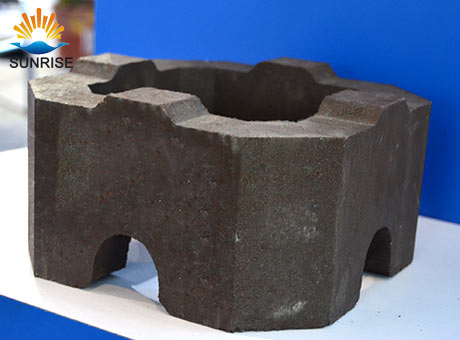Hot Product
Refractory Knowledge
Do you know what factors will affect the performance of magnesia chrome bricks?
Date:2020-04-07 15:34 From:Zhengzhou Sunrise Refractory Author:admin
As a high-quality supplier of refractory materials in China, sunrise Refractory Materials has been exporting various types of refractory materials for decades. In this process, our company is constantly improving and improving, so that the refractory materials we produce and sell are of higher quality. After research by the company's outstanding engineers and sales team, it is found that the factors that affect the performance of magnesia-chrome bricks are mainly in two aspects: one is the influence of the preparation process on the performance of magnesia-chrome bricks, and the other is the influence of chromium ore on the performance of magnesia-chrome bricks. Next, sunrise Refractory will introduce the influence of the preparation process on the performance of magnesia-chrome brick in detail.
The difference in production process makes the structure of magnesium-chromium materials have obvious differences, which in turn affects the performance of magnesium-chromium bricks. For example, the thermal shock stability of the directly combined magnesia-chrome brick is good, the anti-erosion performance of the electrofusion combined magnesia-chrome brick is strong, and the performance of the semi-combination magnesia-chrome brick is somewhere in between. To this end, this section will discuss in detail the impact of the production process on the performance of magnesia chrome bricks.
1. Organizational structure and performance
The apparent porosity and volume density of magnesium-chromium refractory materials prepared by different production processes.
The porosity and volume density of magnesium chromium refractory materials with different processes are quite different, and the change law of the porosity is as follows: silicate combined magnesium chromium refractory (T)> directly combined magnesium chromium refractory (C)> semi-recombined magnesium chromium Refractory (B)> Electrofusion combined with magnesium-chromium refractory (D); the volume density is in the opposite trend. This is mainly caused by different processes. High-quality magnesia-chrome bricks (electric fusion recombined magnesia-chrome bricks, semi-recombined magnesia-chromium bricks and direct-bonded magnesia-chromium bricks) due to their high purity of raw materials, high molding pressure and high firing temperature Therefore, the structure of the product is dense, the porosity is low, and the bulk density is large. It can be seen that the production process has a great influence on the performance of refractory materials.
The effect of production process on the high temperature strength of magnesium chromium refractory.
The change law of high-temperature strength of magnesium-chromium refractory materials with different processes is as follows: silicate combined with magnesium-chromium refractory materials <directly combined with magnesium-chromium refractory materials <semi-combined magnesium-chromium refractory materials <electric fusion followed by magnesium-chromium refractory materials Since the high-temperature flexural strength mainly represents the combination of various minerals in the brick, this shows that the fusion strength of the electro-fused magnesium-chromium brick is the largest, so its anti-erosion erosion ability is the best at high temperature.
Since the permeability of the liquid phase between different grains is lower than that between the same grains, when the liquid content is fixed, the presence of the second solid phase will increase the solid-solid contact, which can increase the high temperature of the brick strength. When producing electromagnetized recombined magnesia-chromium bricks or semi-recombined magnesia-chromium bricks, pre-synthesized magnesia-chromium sand is added as a raw material, thereby increasing the content of the second solid phase and increasing the high-temperature strength of the brick.
The change law of high-temperature strength of magnesium-chromium refractory materials with different processes is as follows: silicate combined with magnesium-chromium refractory materials <directly combined with magnesium-chromium refractory materials <semi-combined magnesium-chromium refractory materials <electric fusion and then combined with magnesium-chromium refractory materials. Since the high-temperature flexural strength mainly represents the combination of various minerals in the brick, this shows that the fusion strength of the electro-fused magnesium-chromium brick is the largest, so its anti-erosion erosion ability is the best at high temperature.
Since the permeability of the liquid phase between different grains is lower than that between the same grains, when the liquid content is fixed, the presence of the second solid phase will increase the solid-solid contact, which can increase the high temperature of the brick strength. When producing electromagnetized recombined magnesia-chromium bricks or semi-recombined magnesia-chromium bricks, pre-synthesized magnesia-chromium sand is added as a raw material, thereby increasing the content of the second solid phase and increasing the high-temperature strength of the brick.

2. Thermal shock stability
The thermal shock stability of various magnesia-chromium bricks was compared with the residual strength percentage after using 1100 ℃ and air cooling once. The results are shown in Figure 3-7. It can be seen from Figure 3-7 that the ordinary magnesium-chromium bricks with different production processes have the best thermal shock stability, followed by semi-reinforced magnesium-chromium bricks and direct-bonded magnesium-chromium bricks, and the worst in electrofusion and magnesium-chromium bricks. .
3. Slag resistance
Because the intercrystalline spinel is precipitated from the silicate liquid phase, the presence of a small amount of SiO2 is beneficial to the formation of intercrystalline spinel. However, if the content of SiO2 is too much, the amount of liquid phase will increase significantly, thereby reducing the high-temperature strength of the magnesia-chromium brick and helping the penetration of the external melt along the liquid phase channel, which will increase the erosion. If the CaO content is high, the temperature of the liquid phase will be significantly reduced, which is not good for high temperature strength and corrosion resistance, especially when the content of A12O3 and Fe2O3 in the magnesia-chrome brick is high. Therefore, when making high-quality magnesia-chrome bricks, chromium ore with low content of SiO2, CaO, Fe2O3 (FeO) and high content of Cr2O3 and A12O3 should be selected as raw materials.
Inquiry:
If you have any questions or good suggestions on our products and site, or if you want to know more information about our products, please write them and send to us, a representative will contact you within one business day. We guarantee that your information will not be divulged to the third party.

